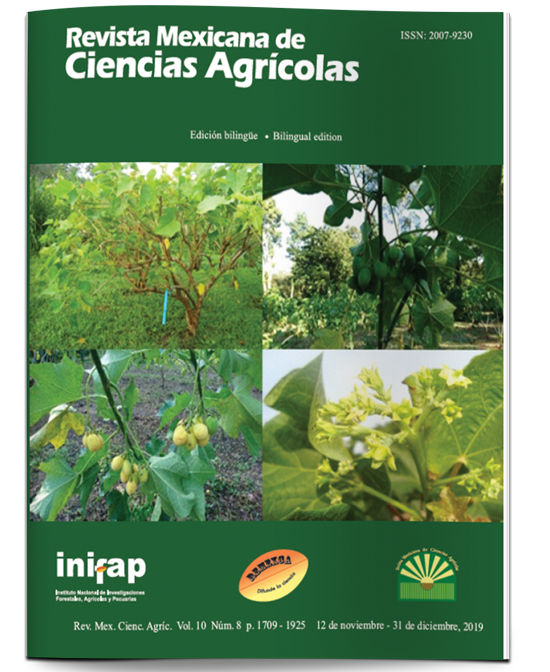Productivity of two Mexican potato genotypes in perlite and aggregates in hydroponics and greenhouse
DOI:
https://doi.org/10.29312/remexca.v10i8.1936Keywords:
aggregates, perlite, prebasic seed II, tuberAbstract
In order to determine the productive response of two Mexican potato genotypes in two substrates in the hydroponic cultivation system, three experiments were established with horticultural grade perlite and with the mixture of perlite with peat 1:1 v/v (aggregates), by what experiments were established in the autumn 2015, spring 2016 and summer 2016 cycles. With perlite, the Citlali variety and clone 99-39, produced on average 15.92 and 34.25 tubers per plant, respectively; in aggregates they produced 11.92 and 15.42 tubers per plant, respectively. Genotype 99-39 exceeded Citlali by up to 10.9 tubers per plant on average of the three crop cycles and produced 2.2 times more tubers in autumn than in spring, as well as 2.9 more tubers in autumn than in summer. Citlali produced 3.6 times more tubers in autumn than in summer and five times more in autumn than in spring. The most efficient substrate was horticultural grade perlite, clone 99-39 was more productive than the Citlali variety, the production of tubers in both genotypes was closely affected by the season of the year and the results will allow decisions on the management of the production of prebasic seed II in both genotypes.
Downloads
Published
How to Cite
Issue
Section
License
The authors who publish in Revista Mexicana de Ciencias Agrícolas accept the following conditions:
In accordance with copyright laws, Revista Mexicana de Ciencias Agrícolas recognizes and respects the authors’ moral right and ownership of property rights which will be transferred to the journal for dissemination in open access. Invariably, all the authors have to sign a letter of transfer of property rights and of originality of the article to Instituto Nacional de Investigaciones Forestales, Agrícolas y Pecuarias (INIFAP) [National Institute of Forestry, Agricultural and Livestock Research]. The author(s) must pay a fee for the reception of articles before proceeding to editorial review.
All the texts published by Revista Mexicana de Ciencias Agrícolas —with no exception— are distributed under a Creative Commons License Attribution-NonCommercial 4.0 International (CC BY-NC 4.0), which allows third parties to use the publication as long as the work’s authorship and its first publication in this journal are mentioned.
The author(s) can enter into independent and additional contractual agreements for the nonexclusive distribution of the version of the article published in Revista Mexicana de Ciencias Agrícolas (for example include it into an institutional repository or publish it in a book) as long as it is clearly and explicitly indicated that the work was published for the first time in Revista Mexicana de Ciencias Agrícolas.
For all the above, the authors shall send the Letter-transfer of Property Rights for the first publication duly filled in and signed by the author(s). This form must be sent as a PDF file to: revista_atm@yahoo.com.mx; cienciasagricola@inifap.gob.mx; remexca2017@gmail.
This work is licensed under a Creative Commons Attribution-Noncommercial 4.0 International license.



